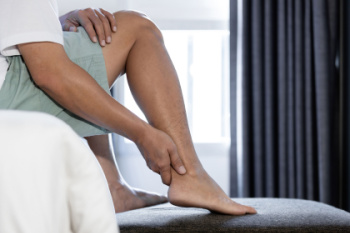
Achilles tendon injuries occur when the tendon connecting the calf muscles to the heel becomes strained, inflamed, or torn. This can happen from sudden movements, overuse during sports, or improper stretching. Common injuries include tendinitis or inflammation, and ruptures, which can be partial or complete tears. Symptoms often include pain or stiffness at the back of the heel, swelling, and difficulty walking or standing on tiptoes. A snapping or popping sensation may occur during a rupture, often followed by severe pain and inability to push off the foot. Diagnosis involves a physical exam and imaging like an ultrasound or MRI scans to assess the extent of the injury. Treatment varies, as mild cases may need rest and targeted exercising, while severe ruptures may require surgery. If you are experiencing Achilles tendon pain, it is suggested that you see a podiatrist for expert care and a tailored recovery plan.
Achilles tendon injuries need immediate attention to avoid future complications. If you have any concerns, contact Troy Wilde, DPM of Practice. Our doctor can provide the care you need to keep you pain-free and on your feet.
What Is the Achilles Tendon?
The Achilles tendon is a tendon that connects the lower leg muscles and calf to the heel of the foot. It is the strongest tendon in the human body and is essential for making movement possible. Because this tendon is such an integral part of the body, any injuries to it can create immense difficulties and should immediately be presented to a doctor.
What Are the Symptoms of an Achilles Tendon Injury?
There are various types of injuries that can affect the Achilles tendon. The two most common injuries are Achilles tendinitis and ruptures of the tendon.
Achilles Tendinitis Symptoms
- Inflammation
- Dull to severe pain
- Increased blood flow to the tendon
- Thickening of the tendon
Rupture Symptoms
- Extreme pain and swelling in the foot
- Total immobility
Treatment and Prevention
Achilles tendon injuries are diagnosed by a thorough physical evaluation, which can include an MRI. Treatment involves rest, physical therapy, and in some cases, surgery. However, various preventative measures can be taken to avoid these injuries, such as:
- Thorough stretching of the tendon before and after exercise
- Strengthening exercises like calf raises, squats, leg curls, leg extensions, leg raises, lunges, and leg presses
If you have any questions please feel free to contact our offices located in Phoenix, Gilbert, and Chandler, AZ . We offer the newest diagnostic tools and technology to treat your foot and ankle needs.
